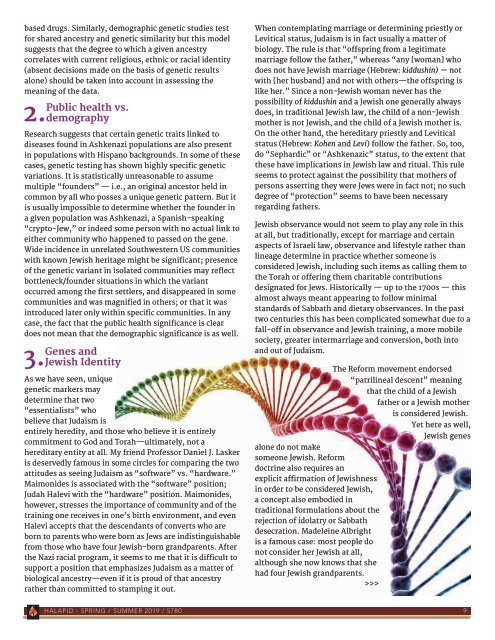HaLapid-Spring Summer 2019
Create successful ePaper yourself
Turn your PDF publications into a flip-book with our unique Google optimized e-Paper software.
ased drugs. Similarly, demographic genetic studies test<br />
for shared ancestry and genetic similarity but this model<br />
suggests that the degree to which a given ancestry<br />
correlates with current religious, ethnic or racial identity<br />
(absent decisions made on the basis of genetic results<br />
alone) should be taken into account in assessing the<br />
meaning of the data.<br />
Public health vs.<br />
2. demography<br />
Research suggests that certain genetic traits linked to<br />
diseases found in Ashkenazi populations are also present<br />
in populations with Hispano backgrounds. In some of these<br />
cases, genetic testing has shown highly specific genetic<br />
variations. It is statistically unreasonable to assume<br />
multiple “founders” — i.e., an original ancestor held in<br />
common by all who posses a unique genetic pattern. But it<br />
is usually impossible to determine whether the founder in<br />
a given population was Ashkenazi, a Spanish-speaking<br />
“crypto-Jew,” or indeed some person with no actual link to<br />
either community who happened to passed on the gene.<br />
Wide incidence in unrelated Southwestern US communities<br />
with known Jewish heritage might be significant; presence<br />
of the genetic variant in isolated communities may reflect<br />
bottleneck/founder situations in which the variant<br />
occurred among the first settlers, and disappeared in some<br />
communities and was magnified in others; or that it was<br />
introduced later only within specific communities. In any<br />
case, the fact that the public health significance is clear<br />
does not mean that the demographic significance is as well.<br />
Genes and<br />
3. Jewish Identity<br />
As we have seen, unique<br />
genetic markers may<br />
determine that two<br />
“essentialists” who<br />
believe that Judaism is<br />
entirely heredity, and those who believe it is entirely<br />
commitment to God and Torah—ultimately, not a<br />
hereditary entity at all. My friend Professor Daniel J. Lasker<br />
is deservedly famous in some circles for comparing the two<br />
attitudes as seeing Judaism as “software” vs. “hardware.”<br />
Maimonides is associated with the “software” position;<br />
Judah Halevi with the “hardware” position. Maimonides,<br />
however, stresses the importance of community and of the<br />
training one receives in one’s birth environment, and even<br />
Halevi accepts that the descendants of converts who are<br />
born to parents who were born as Jews are indistinguishable<br />
from those who have four Jewish-born grandparents. After<br />
the Nazi racial program, it seems to me that it is difficult to<br />
support a position that emphasizes Judaism as a matter of<br />
biological ancestry—even if it is proud of that ancestry<br />
rather than committed to stamping it out.<br />
When contemplating marriage or determining priestly or<br />
Levitical status, Judaism is in fact usually a matter of<br />
biology. The rule is that “offspring from a legitimate<br />
marriage follow the father,” whereas “any [woman] who<br />
does not have Jewish marriage (Hebrew: kiddushin) — not<br />
with [her husband] and not with others—the offspring is<br />
like her.” Since a non-Jewish woman never has the<br />
possibility of kiddushin and a Jewish one generally always<br />
does, in traditional Jewish law, the child of a non-Jewish<br />
mother is not Jewish, and the child of a Jewish mother is.<br />
On the other hand, the hereditary priestly and Levitical<br />
status (Hebrew: Kohen and Levi) follow the father. So, too,<br />
do “Sephardic” or “Ashkenazic” status, to the extent that<br />
these have implications in Jewish law and ritual. This rule<br />
seems to protect against the possibility that mothers of<br />
persons asserting they were Jews were in fact not; no such<br />
degree of “protection” seems to have been necessary<br />
regarding fathers.<br />
Jewish observance would not seem to play any role in this<br />
at all, but traditionally, except for marriage and certain<br />
aspects of Israeli law, observance and lifestyle rather than<br />
lineage determine in practice whether someone is<br />
considered Jewish, including such items as calling them to<br />
the Torah or offering them charitable contributions<br />
designated for Jews. Historically — up to the 1700s — this<br />
almost always meant appearing to follow minimal<br />
standards of Sabbath and dietary observances. In the past<br />
two centuries this has been complicated somewhat due to a<br />
fall-off in observance and Jewish training, a more mobile<br />
society, greater intermarriage and conversion, both into<br />
and out of Judaism.<br />
The Reform movement endorsed<br />
“patrilineal descent” meaning<br />
that the child of a Jewish<br />
father or a Jewish mother<br />
is considered Jewish.<br />
Yet here as well,<br />
Jewish genes<br />
alone do not make<br />
someone Jewish. Reform<br />
doctrine also requires an<br />
explicit affirmation of Jewishness<br />
in order to be considered Jewish,<br />
a concept also embodied in<br />
traditional formulations about the<br />
rejection of idolatry or Sabbath<br />
desecration. Madeleine Albright<br />
is a famous case: most people do<br />
not consider her Jewish at all,<br />
although she now knows that she<br />
had four Jewish grandparents.<br />
>>><br />
<strong>HaLapid</strong> - SPRING / SUMMER <strong>2019</strong> / 5780 9



